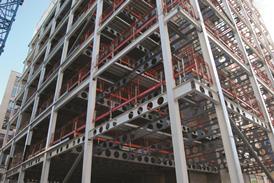The re-appointment of Michael Gove as housing secretary means its back to the future in policy terms for the government and this could also mean the return of fraught discussions with the industry about building safety costs, writes Joey Gardiner
Michael Gove does not bear much of a resemblance to the young Michael J Fox but, by re-appointing him as housing secretary, Rishi Sunak looks set to have taken the housing sector straight back to the future in policy terms.
And, while we are hardly heading to 1955 in a DeLorean, the early signs from the Department for Levelling Up, Housing and Communities’ (DLUHC) are that Gove is intent on reprising almost entirely his agenda from before his surprise 6 July sacking by Boris Johnson – a last-ditch attempt at a show of strength which was not enough to save the former PM.
Housebuilders can hardly be expected to greet Gove’s second tenure with whoops of delight. During 10 months at the department, he refused to meet with trade bodies or chief execs of major firms, and ruthlessly took advantage of the sector’s profits – under dire threats of putting firms out of business – to resolve the running sore of the industry-wide cladding crisis.

But, if housebuilders are not celebrating, many in the wider residential development sector are more positive, given the relative stability provided by a return to a pre-existing agenda, alongside Gove’s heavy-hitter status and reputation as an effective Whitehall deliverer. Nonetheless, even if the policy agenda is the same, the politics and the economics around housing are now very different. So, what can we expect from Gove 2.0?
Back with a vengeance
It is clear from his public statements that Gove wants to return in large part to his pre-July planning reform agenda, despite growing pressure from the Conservative backbenches – fuelled by promises from both Sunak and Liz Truss in their summer leadership campaigns – for a complete abolition of housing targets.
Prior to July, Gove had put a series of planning reforms in train via the Levelling-Up and Regeneration Bill (LURB). The most significant of these were probably the proposal to replace the current system of developer contributions via section 106 and CIL with a new infrastructure levy, and the plan to bring in powers for the government to write a series of central nationally-applied local plan policies covering key areas, called National Development Management Policies (NDMPs). Last week the new housing minister, Lucy Frazer, said the Bill would be pushed forward to “deliver new homes that enrich communities”, effectively confirming it as a key priority.
Gove had also promised a review of the National Planning Policy Framework, designed to both end the requirement for councils with in-date local plans to show a five-year supply of housing land, and set out what the new NDMPs will actually be. His return will also see in-vogue policy ideas such as street votes – also contained in the LURB – and the beauty agenda around design codes given fresh impetus. Insiders saying that Gove has already re-energised the work of the newly-formed Office for Place, and this week he railed at the “disappointing” designs of major developers, confirmed his backing for design codes, and said he will “use all the powers we have in order to make sure that developments which are not aesthetically of high quality don’t go ahead.”
Gove had stripped most of the controversial elements from the 2020 Planning for the Future white paper out of the Bill, with only NDMPs still provoking significant internal opposition. Much of the pressure from planning campaigners and the housing sector is likely to be focused around trying to get more detail of how the policies contained in the Bill – such as the infrastructure levy and street votes – will actually work, given the lack of clarity on the face of the legislation.
Top-down targets
The corollary implication is that almost the entire Truss-era planning agenda will now be ditched – from the investment zones (the chancellor’s autumn statement said these would be switched to benefit research clusters) to the rushed attempt at wider deregulatory “supply-side” planning reforms. Truss’s other big planning promise was to abandon “Stalinist” top-down housing targets, which it was assumed referred both to the overall 300,000 homes-a-year manifesto housing pledge and the standard method formula which sets local housing need – a promise that Sunak appeared to match in the summer leadership contest.
However, along with his promises to tighten up green belt rules and introduce use-it-or-lose-it powers to speed up build-out, Sunak has made clear he is “reviewing” all the promises he made in the summer to see if they still apply – and won’t necessarily be held to them.
Gove’s approach on housing targets will likely be a big test of how willing he is to support the reality of housing delivery in the face of tricky party politics
Westminster observers expect the housing secretary’s general aim to be to keep his head down on planning over the next two years and avoid controversy so far as possible. As there is not time for reforms to deliver the new homes that might aid the Conservatives at the ballot box, the feeling is that there would be little to be gained from spending the political capital pushing them through against opposition.
Hence Gove’s approach on housing targets will likely be a big test of how willing he is to support the reality of housing delivery in the face of tricky party politics. Theresa Villiers, an influential leader of the “anti-planning reform” group of Conservative MPs and emboldened by Sunak’s pledge to scrap targets, has said she will table amendments to the Bill to end housing targets and seek government support for this. Sunak, quizzed by Villiers on the issue in the Commons last week, said that he wanted “decisions to be taken locally with greater say for local communities rather than distant bureaucrats”, but he did not make any formal commitment – and passed the buck on to Gove.
So, while Gove’s Kuenssberg Show statement that he still regards the 300,000-homes figure as a target may be academic in light of the economic downturn, his support for “a fair way of allocating housing need that takes account of changes in population” is important because, crucially, it implies he wants to reform how local targets are created, but not abolish them.
Huge pressure
Planning is by no means the only issue of vital importance to the housing industry in Gove’s remit, with the former education and environment secretary also pushing through reforms to post-Grenfell building safety, rented housing and leasehold, and in charge of funding for affordable housing and regeneration. Gove has often made plain his support for the development of more social and affordable housing but his ability to actually persuade the chancellor to deliver any further funding will be limited given the state of public finances – despite the huge pressures put on the £11.5bn programme by soaring construction inflation. In August the DLUHC admitted that inflation risked derailing the government’s flagship affordable homes programme – designed to deliver 162,000 homes over five years – and since then market concerns over delivery of the programme have deepened.
Gove’s last period in the post was defined by how he gripped the building safety agenda, twisting housebuilders’ arms to get a £2bn commitment from the biggest firms to fix fire safety defects going back 30 years. These “heads of terms” agreements were never contracted while he was in office, and the industry pushed back hard on the detailed documentation over the summer. Persimmon for example was last week forced to increase its estimate of liability under the pledge from £75m to £350m.
Gove appears up for a fight, making clear that he would not allow the worsening economic environment to be used as a reason to “lessen” the burden placed on developers’ shoulders to pay for safety repairs
Housebuilders, negotiating via the Home Builders’ Federation, are nevertheless now close to signing the compromise documents. Housebuilding industry sources suggest that Gove will face a direct confrontation with major PLC builders if he decides he cannot live with the changes that have been made, as darkening market conditions have left the PLCs with little financial room for manoeuvre.
>> See also: Gove is back - the key questions for the returning housing secretary
>> See also: What the new building safety act means
In addition, Gove’s plans for a £3bn levy on all major residential permissions to pay for fire safety repairs to “orphan” buildings are something that housebuilders vigorously oppose, with the industry arguing they will have already paid for repairs via the pledge and through the existing £2bn residential property developer tax. But Gove appears up for a fight, making clear that he would not allow the worsening economic environment to be used as a reason to “lessen” the burden placed on developers’ shoulders to pay for safety repairs.
“It cannot be the case that economic conditions, which affect us all, are being used by developers, or anyone else, to shuffle off their obligations,” Gove said. “Yes, these are tough economic times, but they are very tough economic times for the most vulnerable in our society, and there is no way that PLCs and other organisations with healthy balance sheets and surpluses, and CEOs who are earning handsome remuneration, can somehow use global economic conditions as an excuse for shuffling off their responsibility.”
Developers can expect more of what they saw at the start of the year from Gove – and, given the impending recession, that could mean a fight is on the cards.
Joey Gardiner is ��ɫ����TV’s contributing editor
Coverage of the autumn statement
Coverage of the autumn statement
>> Autumn statement at-a-glance: Tax rises and spending cuts as OBR forecasts recession
>> Infrastructure spared in autumn statement as Hunt commits to £600bn investment
>> Hunt reverses Kwarteng’s ‘permanent’ stamp duty cut from 2025
>> Industry welcomes £6bn funding for energy efficiency measures


























No comments yet